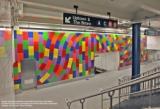
NEW YORK, NY -- At the beginning of 2005, the Metropolitan Transport Authority (MTA) presented a challenge for Spanish tile manufacturer Alcalagres via its "Art For Transit" department: to capture on porcelain tile the works of one of the fathers of conceptual art and minimalism from the past century, Sol LeWitt.
LeWitt was born in Hartford, CT, in September 1928 and died in New York in April 2007. He was a versatile artist who used painting, drawing, photography and structures (a term he liked to use for his sculptures), as predominant forms of expression and to convey concepts.
He drew his first mural in 1968 using pencil on a wall and made over 1,200 since then, and his work was described as something "in which shape and color prevail, conveying concepts-ideas. His works were presented as something alive and moving, and the apparent simplicity causes an enormous visual impact on onlookers."
"The ideas do not need to be complex," he toldArtforummagazine in 1967. "Most ideas that are successful are ludicrously simple. Successful ideas generally have the appearance of simplicity because they seem inevitable."
His moving murals make the spectator feel integrated in a scene of shapes that cause surprise, and their size invites spectators to look at them and follow them actively.
Following this line of visual impact and movement, the MTA Art For Transit decided to offer and delight passengers at New York's 59th Street-Columbus Circle Metro station with a series of these ideas-concepts conveyed in the work "MTA Whirls & Twirls-Estate of Sol LeWitt©." The challenge for Alcalagres was "following the guidelines of the artist like the conductor of an orchestra to portray his work," according to the company, adding that it turned out to be a hard and long task.
"This is the first time that LeWitt's work has been portrayed in ceramic, and this in itself represented an added handicap to our work," stated Alcalagres. "The artist's idea of the color and type of colors in the composition was extremely clear and represented a very important part of the concept that he wished to convey through his work, but these colors had not been conceived using ceramic colors, but rather, following other patterns. When transferring them to porcelain tile and glazing it, the final color differed in some shades of the color pattern contemplated by the artist. However, following the Alcalagres mission since its beginnings, dozens of tests and in-depth research were carried out into the colors so that the MTA and Mr. LeWitt could see their ideas brought to fruition."
The tile wall mural measures approximately 1,076 square feet and was installed on the front wall of the station entrance. It is comprised of six colors -- red, purple, blue, green, yellow and orange -- in geometrically simple shapes, which are interlinked like a never-ending chain that snakes along the wall on vertical lines of color. They are simple yet dynamic shapes and colors, which contain enormous visual power and make the onlooker feel "part" of the work, according to Alcalagres.
Communication between MTA Art For Transit, the artist's assistants and Alcalagres was always smooth. As a result, when they visited the company's plant in Camarma de Esteruelas, Spain, in 2006, the results were satisfactory and immediately approved, according to Alcalagres. Unfortunately, LeWitt was unable to witness the final installed work due to his death in 2007, but both MTA and the artist's family were extremely pleased with the final result. According to Alcalagres, the artist's instructions for this project were continually followed during the process. The mural was installed during the summer of 2009.
"We would like to thank the Metropolitan Transport Authority Art For Transit and Mr. LeWitt's family for the trust placed in our company to carry out such a special piece of art work," stated the tile manufacturer. "We particularly appreciate that our company was chosen from all the national and foreign ceramic companies for which we are deeply honored and immensely proud."







